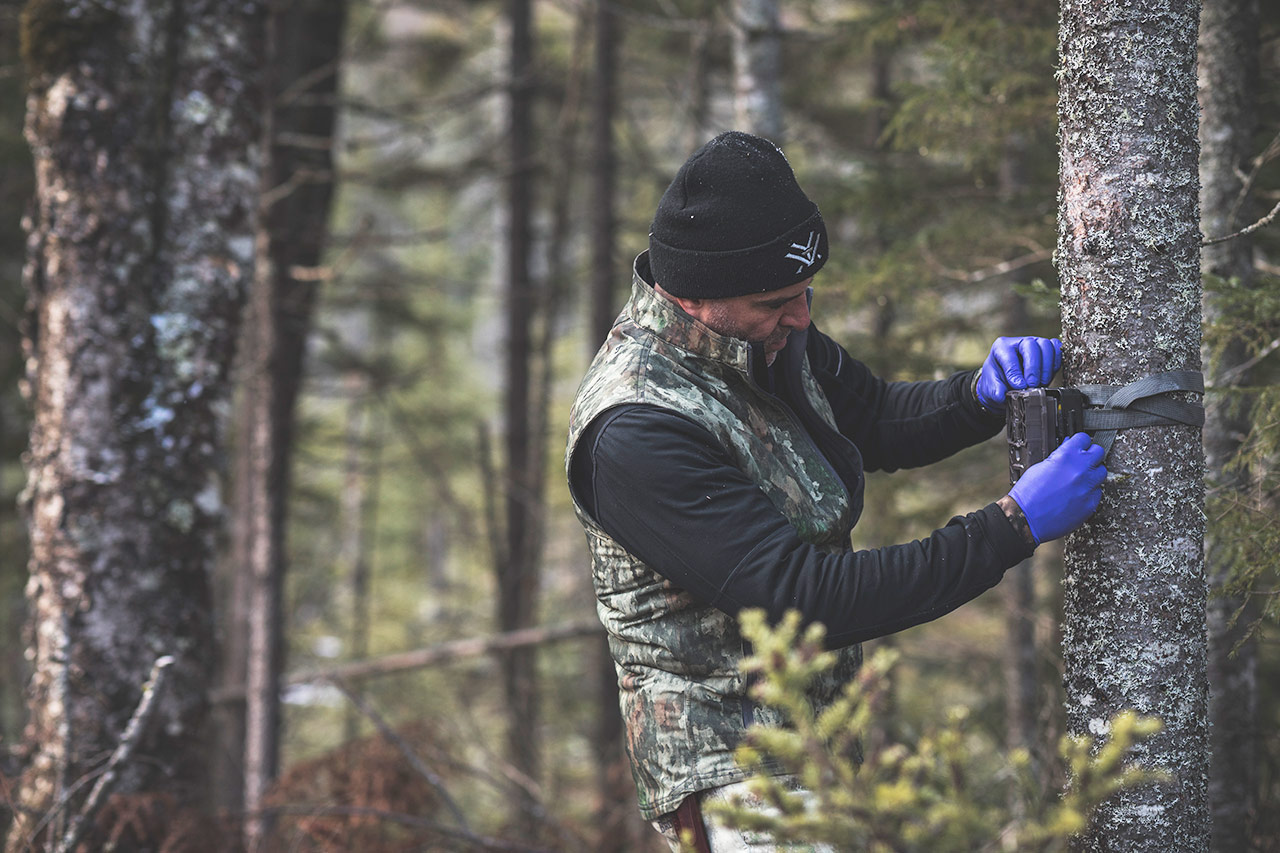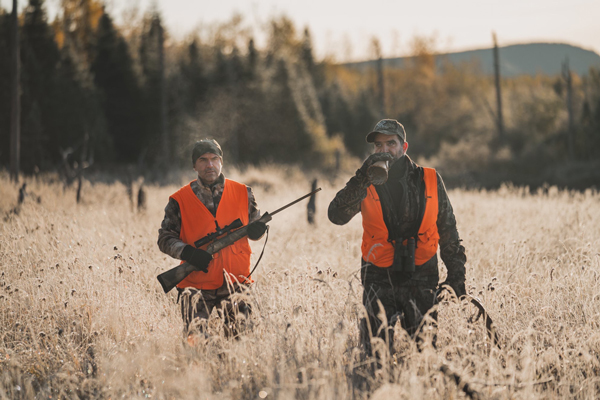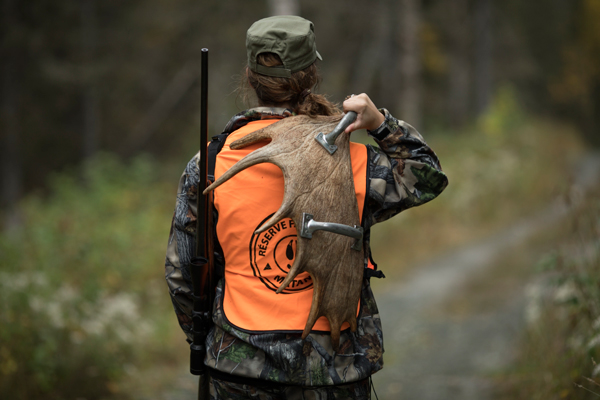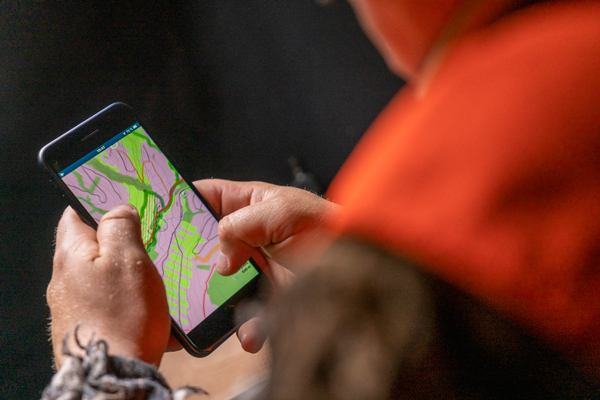The essential tools for moose hunting
By Michel Therrien, hunting guide and columnist.
With the collaboration of Claude Bissonnette, hunting enthusiast and hunting category manager and Martin Léonard, hunting category buyer at SAIL plein air.
Surveillance cameras
I love to learn about and spy on moose behaviour. That's why the contribution of surveillance cameras has become a must for me.
Personally, I like to record images of moose using natural passageways, such as the edges of feeding grounds, including woodlots and savannahs teeming with alder trees. I also like to spy on moose trails or open environments such as small ponds in the forest, as well as wetlands such as non-flooded peat bogs, showing a succession of tracks all around them.
I know that most cameras are installed in front of salt marshes, but you'll learn a lot of new information by also setting up your cameras based on the fall habitats that moose like. In this regard, I also find it important to check out sectors where the males are used to smearing and rubbing. It is by doing this type of spying that we can identify the moose's more intimate fall locations, in other words, where they gather in small communities around the rutting period. I have often photographed bucks in action less than a kilometre away from a salt marsh that they didn't visit during the summer.
Finally, since most surveillance cameras indicate the weather at the time the photo is taken, I use this technology as a weather "micro station" linked to my hunting sector. With this valuable information, I can draw conclusions about moose behavior as a function of the weather.
In short, I don't just spy on moose, but also on the animal's connection to the forest environment in which it lives, as a function of the fluctuations in climate. In my opinion, it's often information about a moose’s fall behaviour that will make the difference in your hunting success, not always the information you derive from a popular salt marsh in July and August from the same moose that, once fall comes, will sometimes leave the salt marsh in question behind.
Clothes that fit like the skin of a wolf
When you go to a store to buy a hunting outfit, the first piece of information you should give the seller is the type of hunt you're planning to pursue. In fact, a hunter who stalks a moose by moving stealthily like an animal will not have the same requirements as one who practices still hunting from a stalking site.
Options include clothing with resistant membranes that provide protection against wind and rain. In general, these garments are suitable for a more passive hunt where the cold can be more oppressive when waiting. However, this type of clothing does not always offer the desired discretion when overcoming obstacles and when friction occurs against their special surface. On the other hand, when hunters move silently, they do not want to be too wrapped up, and it’s preferable that they remain discreet in their movements. So they’ll turn to any option with a material composition that does not produce noise, ideally a silent garment that breathes easily.
Personally, I like relatively light clothing and I rely on the temperature displayed on quality underwear for the morning and the end of the day. During periods of fluctuating heat, I put the compact underwear in question in a small hunting bag attached to my belt. I also like to have my shoulders free to pivot quickly, either to shoot when needed, to call out comfortably, or to vigorously rattle to my heart’s content.
The option of having several quickly accessible pockets in our clothing is another element to consider, as there are items that should not be stored too far away. When I guide, I like to have my GPS close at hand and protected in a pocket with a closure. I also find it useful to have a second charger ready in a pocket and not to carry loose bullets banging noisily against each other. I like to carry my smart phone equipped with the Avenza Maps application in a small plastic bag, in a coat pocket with a closure on my chest. There are also waterproof cases for your smartphones. This makes it possible to head out without being too weighed down, carrying only what is useful and essential.
Always wear the appropriate footwear
I won't tell you how many hunting boots I have, as it might seem a tad excessive! However, you must understand that my job as a guide involves hunting expeditions ranging from one sector to another, from Gaspésie to Côte-Nord, sometimes passing through Abitibi and New Brunswick. I’m often asked whether there’s such a thing as the perfect hunting boot. Well, in all honesty, I have to tell you that such footwear doesn't exist, especially if you go from one type of ecosystem to another, in particular during different periods in the year.
On the other hand, some models are very well adapted to the location and type of terrain where your hunt will take place. For example, I often start my guiding season very early in the month of September, in cooler spots such as in the Charlevoix mountains and sometimes in the Chic-Chocs. However, these are relatively rugged places and in this type of dry location, wearing a long and heavy rubber boot would be true hell for the hunter/hiker who would accompany me. Thus, during this specific period and in this type of forest, I use highly water-resistant hiking boots that are light and offer excellent ankle support. Then later on, depending on the new habitat visited, I opt for a light hunting boot made of leather or resistant waterproof fabric. Here again, I rely on the lightness of the boot and the quality of a relatively flexible sole that doesn't slip much on slopes.
When the habitat includes wetter environments, I opt for boots of very high quality rubber. There are lower models, between the top of the ankle and the middle of the calf. I use the higher and warmer models at the end of the season when the habitat in question is overflowing with wetlands.
Hunting guides who work extended hours over long seasons often have good advice to offer in this regard, depending on the hunting grounds involved. For my part, I've done other trial runs and I've learned to take into account the extensive trips I make in often diverse environments. In this sense, to remain comfortable, energetic, and even sporty, I always choose a good pair of quality boots, well adapted to the hunting context that awaits me.
See it clearly…and see it all!
How many times have I been on the hunt and discovered, with the help of my binoculars, the tip of an antler partially camouflaged in a savannah? In order to achieve this sighting, and to avoid spreading my scent everywhere unnecessarily, I constantly scan the moose habitat with my precious spotting scopes.
Over the last 15 years, brands have innovated so much that it is now possible to obtain quality approach eyewear at a very good price. I also use an adaptable binocular harness that keeps my optical tool tight to my chest, without any disturbing rocking movement.
For the most passionate and quality hunters, I suggest the use of binoculars with an integrated rangefinder. Indeed, it’s now possible to use two optical tools in one; Nikon and Zeiss offer you this option. Binoculars with an integrated rangefinder offer both magnification of the vision and quick evaluation of the distance between the animal and the hunter, to the nearest metre no less.
The amazing thing about rangefinder binoculars is how quickly the internal laser sight transmits information about the distance between you and your moose. Consequently, if you learn the ballistic performance of your weapon, you'll know how to fire less hazardous shots by determining the exact distance between you and the moose. This is also very important when hunting with a bow or crossbow.
When choosing optical tools, I recommend that you do your homework concerning the warranty packages that companies offer. When hunting, you must "have eyes in the back of your head." But, since moose live in sprawling habitats, I also suggest you have binoculars adapted to your needs, because that bionic eye will sometimes make all the difference.
Choose your weapon according to your physiognomy and hunting style
I'm always astonished to see that some hunters still talk and debate at length about the type of calibre to choose, but very few question the reputation of a mechanism and even less the weight of the weapon.
In Quebec, research has proven that the moose we stalk rarely weigh more than 950 pounds once gutted. In addition, most moose harvested are between about a year and a half and two and a half years old, so they weigh much less than a mature moose. Now, considering this information, is it really necessary to have a large MAGNUM-type calibre to place a lethal shot in the wide and high lungs of a moose?
In order to shoot well, you must at least like your shooting experience and above all not be afraid of your weapon. I believe that there are weapons with an aesthetic and a balance that suits the size and length of everyone's arms.
Beyond the calibre, my first question for a hunter concerned about choosing the right weapon would be to ask in what type of habitat and conditions will they be hunting, and more importantly, what is the preferred approach?
A stalker measuring 5 feet 7 inches and weighing 160 lbs. will look different from a strapping 6 foot 3 inch tall guy weighing 250 lbs. It’s also important to consider the mechanism with which the hunter will be most comfortable, either a bolt gun with a simple and robust mechanism, or a lever or other mechanism that can be tested and handled as needed.
For my part, I like to see the hunters I accompany enjoy the art of shooting, and I'm very much in favour of showcasing smaller calibres, such as the 308, 30-06, 270, and 7 mm-08. Moreover, I particularly like the 6.5 Creedmoor model for the needs of Quebec hunters. Our weapon should, in a way, be a "friendly tool" that we like to carry, clean, and later bequeath.
Keep in mind that the more successful your experiences with a weapon, the more it will be positively visualized and remembered as part of your hunt. This way, it will live on throughout the years by appearing in your very best hunting souvenir photos.




